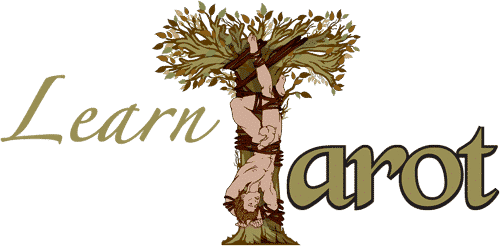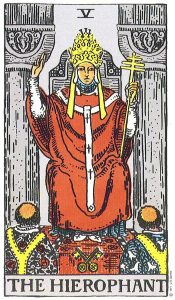

The Fool’s Journey
With what he has learned so far, The Fool is now busy manifesting his desires. One night, he wakes up in a cold sweat, paralyzed by fear. What happens if everything he’s worked for is taken from him? He knows he’s far from perfect, has made many mistakes, and has a long way to go.
The Fool asks himself a question we’ve all asked ourselves many times: “What if I’m not good enough?”
Terrified, he enters a holy place, where he meets the holy Hierophant seated upon a golden throne. The Hierophant’s assistants are gathered at his feet, listening to his spiritual teachings, preparing to teach his spiritual ways to others.
“How do I let go of fear?”
The Hierophant places two keys at his feet, and replies:
“These are the two keys to overcoming fear—two pathways you can take to find peace. The first is to confront your fears directly by giving up whatever it is you fear to lose so that it no longer has power over you. The second is to focus on what you would still have if what you fear actually occurred. You can never lose the knowledge and experience you’ve gained, even at your darkest hour.”
The Fool uses these keys to free himself from the fear he felt, and is able to continue on his journey.
Card Meaning
The story of The Hierophant is one of ancient wisdom based in tradition and ceremony. While The Emperor represents this structure in terms of the mind, the Hierophant represents this structure in the spirit. Spirituality and the course we choose to relate to the unknown, as well as the ceremonies we select to access that unknown, is very personal and hard to pin down with any particular structure. Religion is often born out of a desire to create this structure, which is why this particular card often speaks to pre-defined ideas that have been around for a long time, and set up in a religious context. When the Hierophant appears, he invites you to borrow these pre-existing methods of connecting to Spirit, and to discover what can or cannot work for you in this context.
One of the faults of The Hierophant is his view that tradition outweighs the negative or positive outcomes of such practice. This message is often corrected by this card appearing in its shadowed context, which invites us to seek internal, non-traditional methods or ceremonies to connect to the divine.
Remember that the greatest lesson found in this card is the teachings about fear, and how to overcome the fear of the unknown. We must either choose to confront fear head on, or consider what we might do if a fear is realized, taking our fear to the furthest manifestation in our mind, and planning what we might do accordingly. Don’t set yourself up for failure, but put some plans into place to balance the effects of a possible failure. As you read this card, you may find that one of these fear-handling approaches is suggested by the perspective of the card (upright or shadowed), but which must be learned by your intuition and/or experience.
On a personal level, the Hierophant also represents a teacher or mentor, someone with knowledge, tasked to indoctrinate others or pass down what he or she knows. Because of this, this card can also symbolize a teacher or mentor entering your life, or the need to listen more closely to those who are already in your life, honoring the traditional ways of your teachers or ancestors more closely. From a non-spiritual interpretation, The Hierophant can also represent an employer/employee relationship, or any sort of teaching or training.
If you are planning something revolutionary or out-of-the-box, the repeated appearance of The Hierophant may be an indication that it is best to stick to tradition—your revolution is unlikely to succeed.
Finally, you yourself, as a holder of secret and sacred knowledge, are a Hierophant. Remember that the true Hierophant is someone who has great respect for his beliefs, but won’t follow them blindly to his own destruction.


